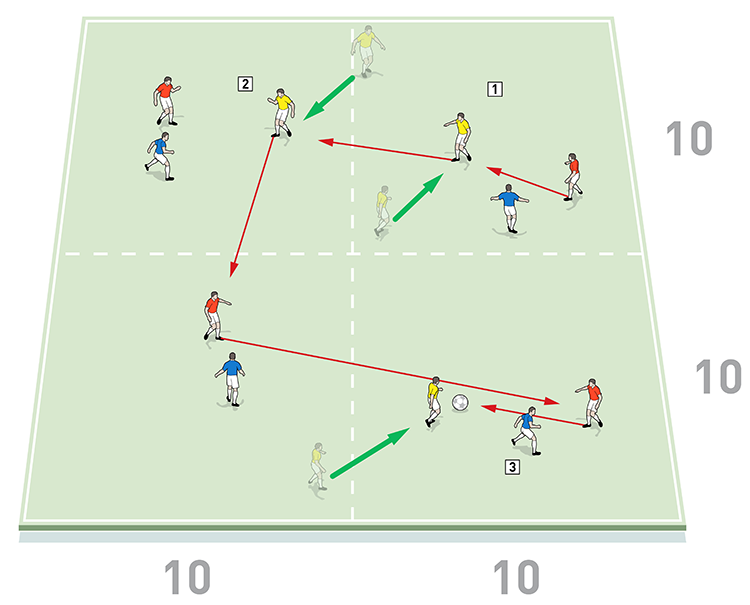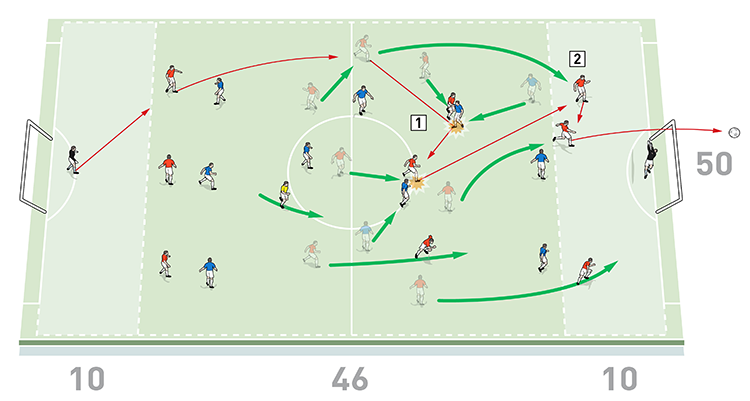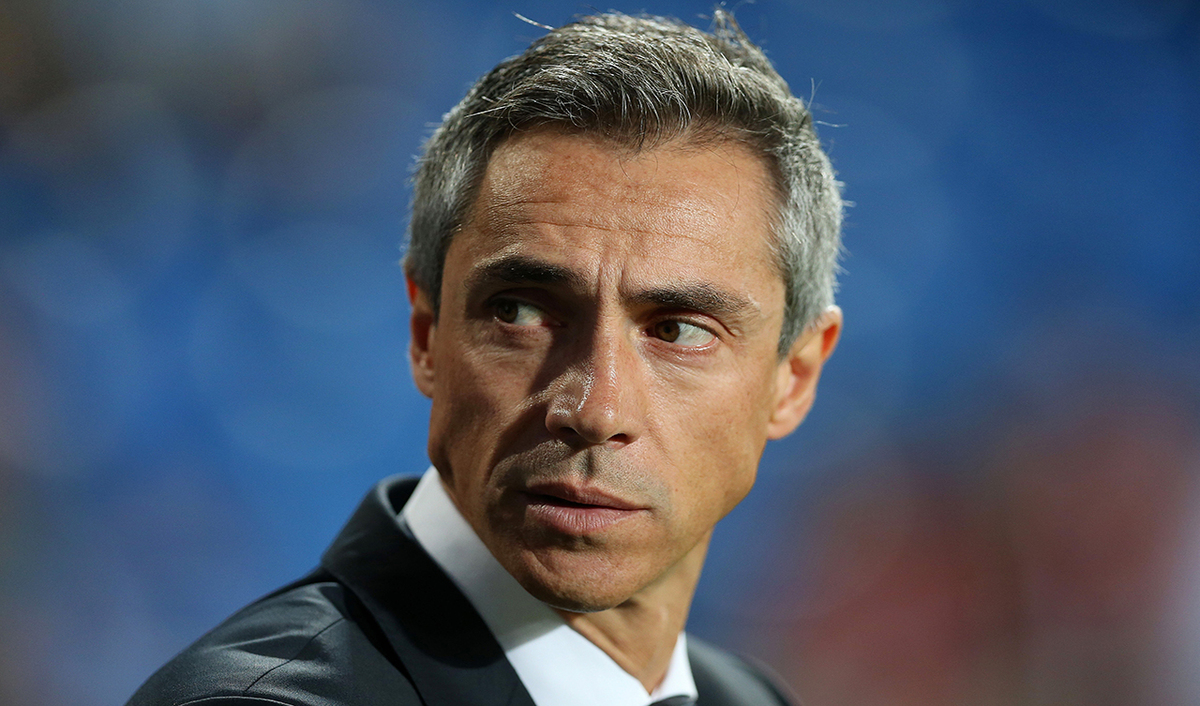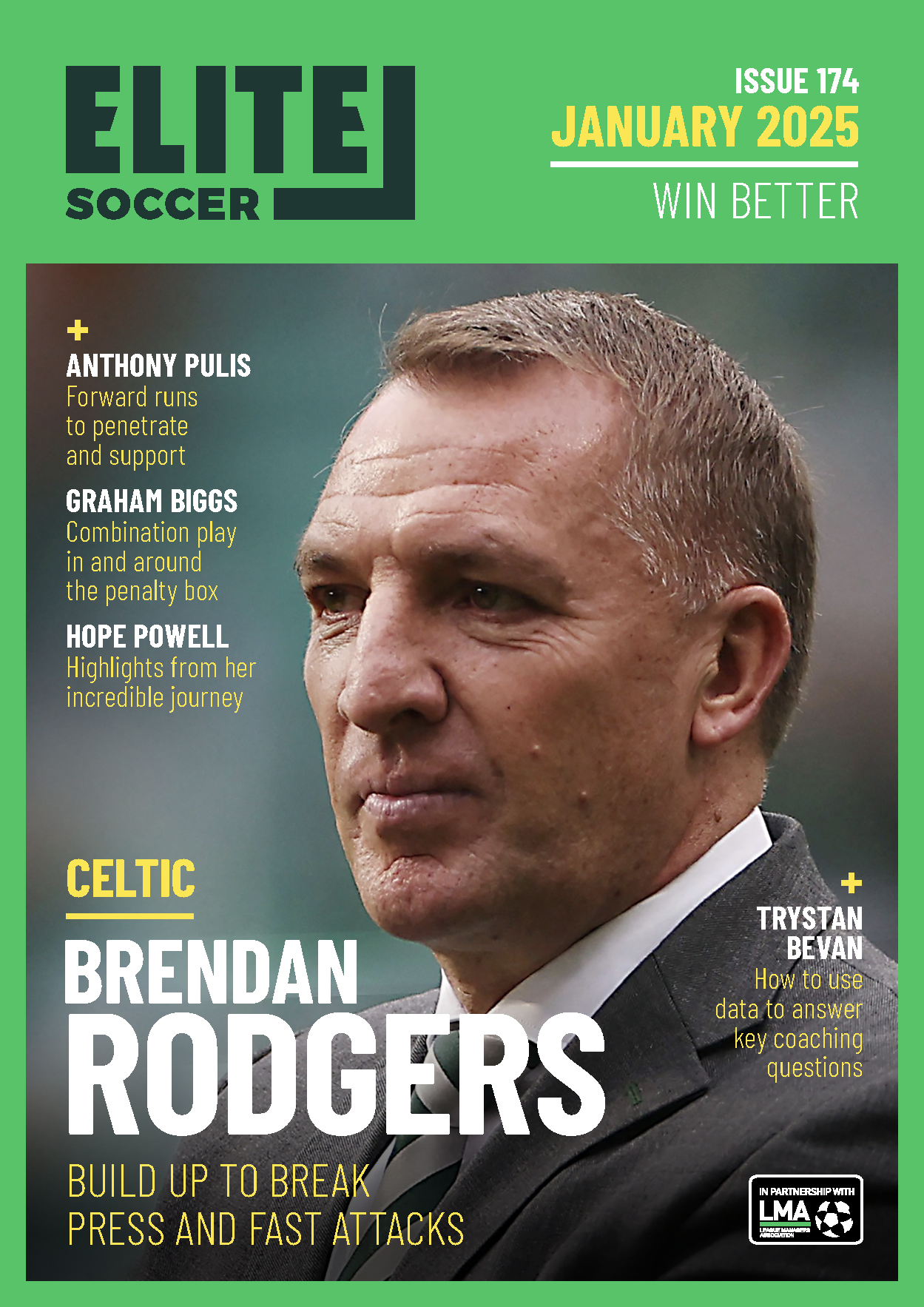You are viewing 1 of your 1 free articles
Attacking play
This session is for offensive play situations when in possession. We will work on aspects of assertive communication, what each player expects from the team and what the team expects from each player within the coach’s plan for the game. We will develop situations that help players understand what they need to do to help their team mates and the play itself. The session will take place in situations with different specificities, ending with strategic aspects for a specific match.
| Area | Up to two thirds of pitch |
| Equipment | Balls, bibs, cones, 2 full size goals |
| No. of Players | Number of Players: Up to 19 players + 2 goalkeepers |
| Session Time |
Passing drill: 20mins, Positional game: 20mins, Situational game: 30mins |
This session is for offensive play situations when in possession. We will work on aspects of assertive communication, what each player expects from the team and what the team expects from each player within the coach’s plan for the game.
We will develop situations that help players understand what they need to do to help their team mates and the play itself. The session will take place in situations with different specificities, ending with strategic aspects for a specific match.
We believe it is essential that anything done in training has an equivalent meaning in a match context for the players. Therefore, anything we propose during the session must be game-related.
The first important aspect is that the ball should take centre stage for these exercises and that all situations are proposed from this perspective. We will give precise information so that players are conscious at all times of why we are doing this exercise and what is expected of them by team mates and by the coach.
This type of session can be recurring as it adapts to the type of play that we want from our team. We may create the situations described here once or twice a week, although no two sessions are ever the same. What we illustrate here in a 4v4+3 exercise may be a 5v5+2 activity in another session; what we show here as a situation play where a team is organized in 4-2-3-1, in another circumstance the team may be set up in a 4-3-3 formation. What we will see repeated are the relations and synergies proposed during the session.
PASSING DRILL
In this exercise players move to create a passing sequence. We are using at least four outfield players and we set up as shown [1], with each player starting in the centre of a box marked out by a series of colour coded cones. Each colour represents a different instruction and players should perform one movement before and one movement after contact with the ball, dependent on the colour cones.
1

2. Player B is in the middle of the cone box. He moves to the yellow cone and then runs diagonally to the blue cone to receive a long pass from player A
3. Player C runs to a yellow cone and then moves diagonally to receive from player B on the blue cone
4. Player C returns the ball to player B, who has run to the central red cone
5. Player C moves to receive a return ball from player B on a red cone before passing long back to player A, who moves to a blue cone to receive at the finish position
Players should move to a yellow cone before a pass is made to them; players should then immediately move to receive the ball on a blue cone; and after making a pass players should move to a red cone to make their next pass, as red cones indicate the following movement. Play is two touch.
The movement before receiving the ball will dictate to the passer when and where the pass should be made. One player starts at each position in the sequence, although at the first position there can be up to three players waiting for their turn to start with the ball.
After running the drill as shown, all three active players move to the next starting position and we would then run the drill again on the left side of the pitch, this time using player D instead of player C.
We would have several groups running at the same time but the dynamics of the passing combinations can and should be varied. Lost balls are counted and for each lost balls, five push ups should be performed.
What are the key things to look for?
We want to see players performing one movement before and one movement after contact with the ball, as indicated by the coloured cones. We don’t want to see players following the line of the ball after the pass, as that is what the colour coded movement indications are for. The player’s run must be different from the passing line.
We play with two touches to accelerate footwork and we want to see accuracy in the pass, with players showing they are able to adjust their passing to the receiving player’s movement.
4v4+3 POSITIONAL GAME
We set up an area of 20x20 yards divided into four 10x10-yard boxes. We’re using 11 players split into two teams of four and a neutral team of three yellows, who play for the team in possession.
The players are set up in the area as shown, with the red possession players starting with one locked in each square but spreading themselves out as much as possible to make the area bigger.
Play starts with the red possession team, who pass with the help of the yellow neutrals, as shown [2a]. The yellow neutral players can move from square to square to help give the passing team an overload in that square.
2a

2. The yellow neutrals play for the team in possession and can move between squares to give the passing team an overload
3. The blue pressing players can go into any square to try and win the ball but if they gain possession they must spread out with one in each square and they become the new passing team, while the reds transition to become the pressing team
The team of four blue pressing players can go into any square to try and win the ball back. The aim for the pressing team is to gain possession but when they win the ball, they must spread out with one in each square and pass the ball to keep hold of it with the help of the yellow neutrals, while the team that lost the ball can press to win it back.
We want to see players recognising the areas with numerical superiority and take the ball to those areas. For example, when there are three pressing players in two of the squares that the passers are playing in, it is time to switch the play to the other side of the area to find the position of superiority. The possession team should then maintain play in the areas of superiority until they attract more opponents towards the ball.
We want to see players using body movement to give information to their team mates about where they want to receive the ball.
We can also run a variation of the activity to utilise the goalkeepers. We position two goalkeepers on opposite sides as neutrals who play for the team in possession, but they can only play from outside the area, as this allows them more time with the ball at their feet. The third neutral is in the main area and is still able to move between squares, as shown [2b].
2b

2. The third neutral is in the main area and is still able to move between squares
3. Players should use body movement to give information to their team mates about where they want to receive the ball
SITUATIONAL GAME WITH DEPTH
We set up a playing area of 66x50 yards between the 18-yard lines of the pitch, with a goal and a goalkeeper at each end. The playing area includes a 10-yard end zone at each end and teams can only score a goal from inside the end zones.
We’re using 19 outfield players split into two teams of nine plus one yellow neutral who plays for the team in possession.
Play starts and restarts from the goalkeeper. The team in possession should build up play to create a scoring opportunity but when they are in the attacking half of the pitch, they must play the ball from one side of the pitch to the other before being able to attack the goal, as shown [3a].
3a

2. When in the attacking half of the pitch, the possession team must play the ball from one side of the pitch to the other before being able to attack the goal
3. It’s important to keep the ball in high areas for several passes, so players can get organised and regain possession as soon as possible when it is lost
4. A goal can only be scored from inside the end zone
However, if possession of the ball is won high up the pitch (beyond the midfield area), the team winning the ball can attack immediately without having to go from one side of the pitch to the other, as shown [3b].
3b

2. If possession is won high up the pitch, the team winning the ball can attack immediately without having to go from one side of the pitch to the other
The objectives of the activity are to recognise the offensive dynamics we expect to see in our game, which may vary from week to week.
We want to see the possession players getting the ball safely to the forward areas of the pitch as early as possible and then keep it there. It’s important to keep the ball in the high areas for several passes, so that players can get well organised and regain possession as soon as possible when it is lost.
We want to see players remaining alert and always ready to play or offer a passing option to team mates. Players must communicate to team mates with their movement, showing them where they want the ball to be played. It’s also important that when a player is distant from the ball, they should take responsibility for their nearest opponent, so they are able to recover the ball as soon as possible after losing it.
Related Files
Editor's Picks
Using the goalkeeper in build-up play
Pressing principles
Intensive boxes drill with goals
Penetrating the final third
Creating and finishing
My philosophy
Pressing initiation
Compact team movement
Defensive organisation
Coaches' Testimonials

Alan Pardew

Arsène Wenger

Brendan Rodgers

Carlos Carvalhal

José Mourinho

Jürgen Klopp

Pep Guardiola

Roy Hodgson

Sir Alex Ferguson

Steven Gerrard
Coaches' Testimonials

Gerald Kearney, Downtown Las Vegas Soccer Club

Paul Butler, Florida, USA

Rick Shields, Springboro, USA

Tony Green, Pierrefonds Titans, Quebec, Canada
Join the world's leading coaches and managers and discover for yourself one of the best kept secrets in coaching. No other training tool on the planet is written or read by the calibre of names you’ll find in Elite Soccer.
In a recent survey 92% of subscribers said Elite Soccer makes them more confident, 89% said it makes them a more effective coach and 91% said it makes them more inspired.
Get Monthly Inspiration
All the latest techniques and approaches
Since 2010 Elite Soccer has given subscribers exclusive insight into the training ground practices of the world’s best coaches. Published in partnership with the League Managers Association we have unparalleled access to the leading lights in the English leagues, as well as a host of international managers.
Elite Soccer exclusively features sessions written by the coaches themselves. There are no observed sessions and no sessions “in the style of”, just first-hand advice delivered direct to you from the coach.









